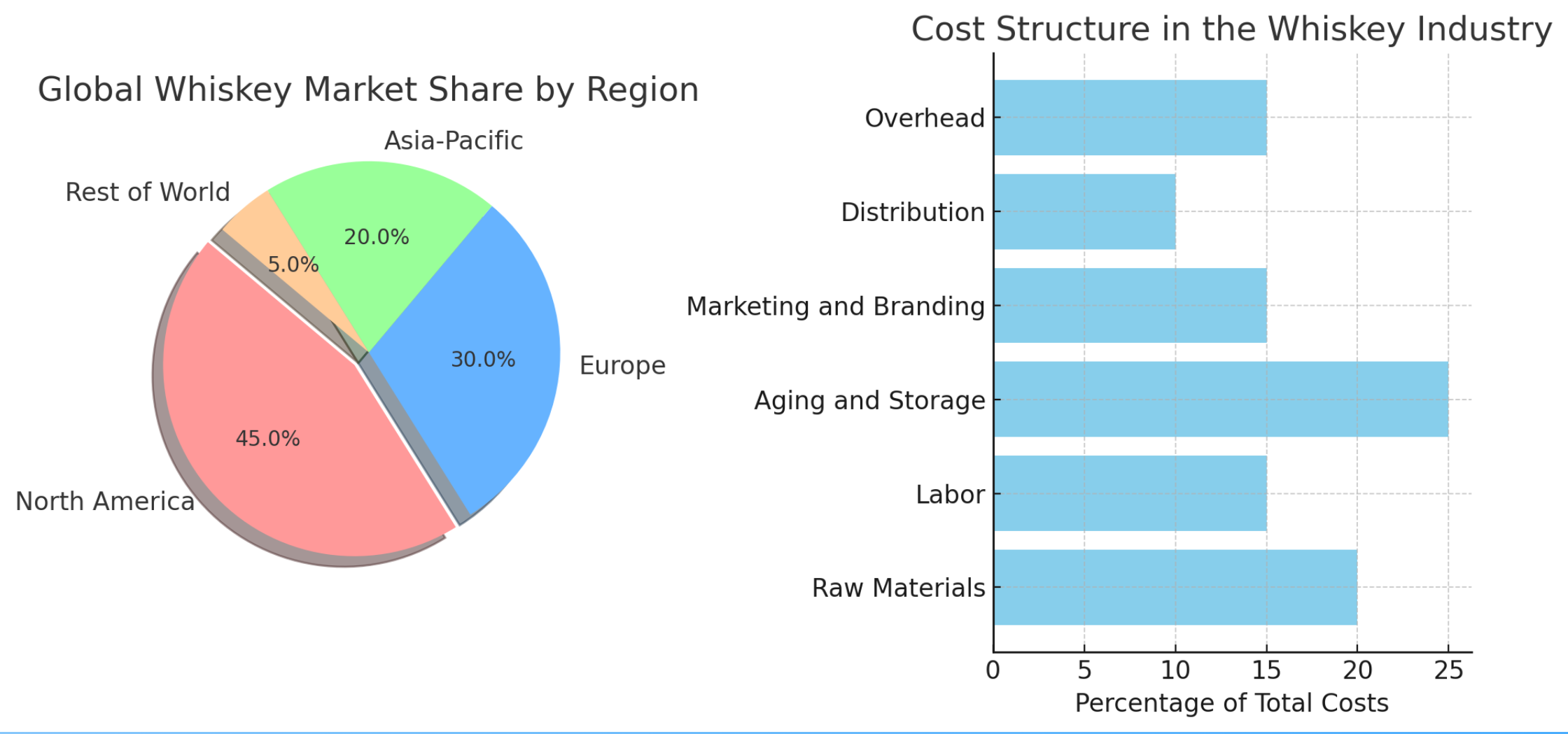
The whiskey industry is a prestigious market blending tradition with modern entrepreneurial ventures. If you’re passionate about whiskey and want to start a whiskey business, understanding the industry’s intricacies, economics, and strategies is essential. This guide will provide an in-depth look at how to enter the whiskey business, including case studies, financial considerations, and practical steps.
Understanding the Whiskey Industry
The global whiskey market has seen significant growth in recent years, driven by rising disposable incomes, increased demand for premium products, and the popularity of whiskey tourism. As of 2023, the global whiskey market is valued at approximately $74 billion and is expected to reach $108 billion by 2030, growing at a CAGR of 5.3% .
Key Players
A number of significant businesses dominate the whiskey market, including:
- Diageo: Owners of brands like Johnnie Walker, Talisker, and Lagavulin. Annual revenue: $17 billion.
- Pernod Ricard: Owners of Chivas Regal, Jameson, and Glenlivet. Annual revenue: $10 billion.
- Beam Suntory: Owners of Jim Beam, Maker’s Mark, and Laphroaig. Annual revenue: $4.6 billion.
These companies have extensive distribution networks, significant marketing budgets, and a strong brand presence globally .
Types of Whiskey
Understanding the different types of whiskey is crucial for entering the market. The primary categories include:
- Scotch Whisky: Made in Scotland, must be aged in oak barrels for at least three years.
- Irish Whiskey: Typically smoother, often triple-distilled.
- Bourbon: American whiskey, made primarily from corn and aged in new charred oak barrels.
- Rye Whiskey: Made primarily from rye, offering a spicier flavor profile.
- Japanese Whisky: Known for its meticulous craftsmanship and often compared to Scotch .
How to Start a Whiskey Business
Step 1: Market Research and Business Plan
To comprehend consumer preferences, market trends, and competition, conduct in-depth market research. A detailed business plan should include:
- Market Analysis: Target demographics, key competitors, and market size.
- Business Model: Distillery, private label, or retail.
- Funding Requirements: Initial investment, operating costs, and potential revenue streams.
- Marketing Strategy: Brand positioning, advertising, and distribution channels .
Step 2: Legal Requirements and Licensing
Navigating the regulatory landscape is crucial. You’ll need:
- Distilling License: Required for producing whiskey.
- Federal and State Permits: In the U.S., the Alcohol and Tobacco Tax and Trade Bureau (TTB) oversees the industry.
- Health and Safety Compliance: Adhering to food safety standards and regulations .
Step 3: Setting Up the Distillery
Location and Equipment
Choosing the right location is essential for both production and brand story. Essential equipment includes:
- Milling and Mashing Equipment: For processing grains.
- Fermentation Tanks: For converting sugars to alcohol.
- Stills: Pot stills or column stills for distillation.
- Aging Barrels: Oak barrels for aging the whiskey.
Initial Investment
The initial investment can vary widely, but a small craft distillery might require $1 million to $5 million. This includes equipment, real estate, licensing, and initial operating costs .
Step 4: Production Process
- Milling: Grinding grains to create a mash.
- Mashing: Mixing grains with water to convert starches to sugars.
- Fermentation: Adding yeast to convert sugars to alcohol.
- Distillation: Purifying the alcohol.
- Aging: Storing the whiskey in barrels to develop flavor.
- Bottling: Packaging the final product for sale .
Step 5: Marketing and Distribution
Branding
Craft an engaging brand narrative that appeals to your intended audience. Your branding should reflect the heritage, craftsmanship, and unique qualities of your whiskey .
Distribution Channels
- Direct-to-Consumer: Online sales and distillery tours.
- Retail: Partnering with liquor stores and supermarkets.
- Bars and Restaurants: Building relationships with hospitality businesses .
Economics of the Whiskey Business
a) Revenue Streams
- Retail Sales: Bottled whiskey sales through various channels.
- Tours and Tastings: Offering distillery tours and tasting sessions.
- Merchandising: Selling branded merchandise .
b) Cost Structure
The cost structure in the whiskey industry includes several key categories:
| Cost Category | Percentage of Total Costs |
|---|---|
| Raw Materials (Grains) | 20% |
| Labor | 15% |
| Aging and Storage | 25% |
| Marketing and Branding | 15% |
| Distribution | 10% |
| Overhead (Utilities, etc.) | 15% |
c) Profit Margins
Profit margins in the whiskey industry can vary. Established brands often see margins of 30-40%, while new entrants might have lower margins initially due to higher startup costs and lower economies of scale .
d) Real-World Financial Data
According to data from the Distilled Spirits Council of the United States (DISCUS), the U.S. whiskey market generated $5.4 billion in revenue in 2022. Tax payments by the industry are substantial. For instance, the federal excise tax on distilled spirits is $13.50 per proof gallon. In addition, state excise taxes can vary widely; for example, in Kentucky, the tax is $1.92 per gallon .
The industry contributes significantly to the economy. In Kentucky alone, the bourbon industry supports over 20,000 jobs and generates $8.6 billion annually. Whiskey tourism adds an additional economic impact, with visitors spending millions on tours, tastings, and merchandise .
Case Study: Maker’s Mark
Maker’s Mark, a well-known bourbon brand, started in the 1950s and has become a significant player in the market. Important tactics that helped make it successful include:
- Unique Branding: The distinctive red wax seal.
- Quality Focus: Consistent flavor profile and premium positioning.
- Tourism: The distillery tour in Loretto, Kentucky, attracts thousands of visitors annually.
Financial Performance
- Revenue: Maker’s Mark generates over $500 million annually.
- Visitor Impact: Over 200,000 visitors annually, contributing millions in tourism revenue.
- Employment: Supports over 200 direct jobs and numerous indirect jobs in the region .
New Entrants and Startups
- WhistlePig: Founded in 2007, WhistlePig focuses on high-end rye whiskey. The company has seen rapid growth and generates annual revenue of around $20 million.
- High West Distillery: Established in 2006, High West has become known for its innovative blends. Acquired by Constellation Brands in 2016 for approximately $160 million, indicating strong market potential.
Case Study: WhistlePig
WhistlePig was founded in Shoreham, Vermont, by Raj Bhakta in 2007. The brand focuses on high-quality rye whiskey and has quickly gained a reputation for excellence.
Financial Performance
- Revenue: WhistlePig generates approximately $20 million annually.
- Funding: Raised significant investment from private equity firms.
- Growth Strategy: Focuses on premium positioning and limited releases to create exclusivity.
Economic Impact
New whiskey startups contribute significantly to the local and national economy. They create jobs, attract tourism, and generate substantial tax revenues.
Practical Financial Planning

Cost to Open a Whiskey Distillery and Initial Investment Breakdown
| Expense | Cost Estimate |
|---|---|
| Real Estate and Construction | $500,000 – $2,000,000 |
| Equipment | $300,000 – $1,000,000 |
| Licensing and Permits | $50,000 – $200,000 |
| Initial Raw Materials | $100,000 – $300,000 |
| Marketing and Branding | $100,000 – $500,000 |
| Working Capital | $200,000 – $500,000 |
| Total Estimated Investment | $1,250,000 – $4,500,000 |
Revenue and Break-Even Analysis
Assuming a small distillery with annual production of 10,000 bottles:
- Average Selling Price per Bottle: $50
- Annual Revenue: $500,000
Annual Costs
| Cost Category | Annual Cost |
|---|---|
| Raw Materials (Grains) | $100,000 |
| Labor | $75,000 |
| Aging and Storage | $125,000 |
| Marketing and Branding | $75,000 |
| Distribution | $50,000 |
| Overhead (Utilities, etc.) | $75,000 |
| Total Annual Costs | $500,000 |
Break-Even Point
When total revenue and total costs are equal, the break-even point is reached. For a small distillery with $500,000 in annual costs and revenue, the break-even point would be approximately in the second year of operation, considering initial setup costs and time to market.
Profitability
Profit margins improve as production scales and brand recognition grows. Established distilleries often see profit margins of 30-40%.
Funding and Investment
- Self-Funding: Using personal savings or assets.
- Bank Loans: Traditional financing options.
- Venture Capital: Attracting investors interested in the spirits industry.
- Crowdfunding: Raising funds through platforms like Kickstarter.
Valuation and Investment Returns
Valuations in the whiskey industry depend on brand strength, production capacity, and market presence. Successful distilleries can see valuations in the hundreds of millions. For example, the sale of Angel’s Envy to Bacardi was reported to be around $150 million .
Economic Impact and Market Share
| Region | Market Share |
|---|---|
| North America | 45% |
| Europe | 30% |
| Asia-Pacific | 20% |
| Rest of World | 5% |
Economic Impact
The whiskey industry significantly impacts local economies, particularly in regions known for whiskey production. For example, in Kentucky, the industry supports over 20,000 jobs and generates $8.6 billion annually .
Taxes and Regulations
Taxes are a significant consideration in the whiskey business. In the U.S., federal excise tax is $13.50 per proof gallon. State taxes vary widely, with some states imposing additional excise taxes and fees .
Practical Steps to Launch Your Whiskey Business
Step 1: Develop a Business Plan
A comprehensive business plan is crucial. Outline your business model, target market, financial projections, and marketing strategy. To determine your strengths, weaknesses, opportunities, and threats, do a SWOT analysis.
Step 2: Secure Funding
Determine how much capital you need and explore various funding options. Whether through personal savings, loans, or investors, ensure you have enough capital to cover initial costs and sustain operations until the business becomes profitable.
Step 3: Find a Location
Choose a location that aligns with your brand story and has the necessary infrastructure. Consider the availability of raw materials, proximity to markets, and local regulations.
Step 4: Obtain Necessary Licenses and Permits
Ensure you comply with all legal requirements, including distilling licenses, health and safety permits, and federal and state regulations.
Step 5: Design Your Distillery
Plan the layout of your distillery, ensuring you have the necessary equipment for milling, mashing, fermenting, distilling, and aging whiskey. Consider future expansion when designing the facility.
Step 6: Source Raw Materials
Build relationships with suppliers for high-quality grains, yeast, and barrels. Consistency in raw materials is crucial for maintaining product quality.
Step 7: Start Production
Begin with small batches to refine your process. Monitor each stage carefully to ensure quality control.
Step 8: Develop Your Brand
Create a unique brand identity that reflects your whiskey’s heritage, quality, and craftsmanship. Invest in professional branding, including logo design, packaging, and marketing materials.
Step 9: Establish Distribution Channels
Develop relationships with distributors, retailers, and hospitality businesses. Explore direct-to-consumer sales through online platforms and distillery tours.
Step 10: Market Your Product
Implement a comprehensive marketing strategy that includes digital marketing, social media, public relations, and events. Build a community around your brand through storytelling and customer engagement.
Conclusion
Establishing a whiskey company involves substantial funding, careful planning, and in-depth knowledge of the market. From market research to production and marketing, every step is crucial for success. By focusing on quality, building a strong brand, and navigating the regulatory landscape, you can carve out a niche in this prestigious market.
Entering the whiskey business is not just about passion for the product but also about understanding the economics and market dynamics. With careful planning and execution, you can build a successful and profitable whiskey brand.

